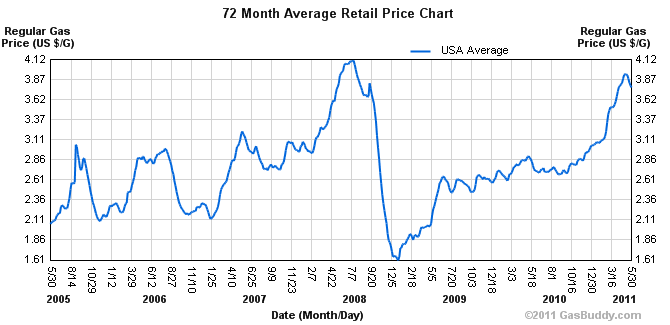We know that motor fuel has been the primary driver in headline CPI over the last few years. This is one of the primary reasons why I’ve been keenly focused on oil and gas prices this year. Any surge in oil prices was likely to result in an inflationary effect and was likely to put pressure on the economy as the summer progressed. Early this year I said:
“This rising inflation trend is likely to continue into the summer months due to seasonal strength in energy. By the middle of this summer we could be staring at a situation that is eerily reminiscent of Summer 2008 when we had a sizable commodity bubble (thanks in part to easy Fed speak) and weak underlying economic trends. The situation is likely to put more pressure on the Fed heading into 2012. The Fed has made their bed and now they must sleep in it. The commodity price pressures (some of which are due to QE) cannot be denied at this juncture. The Feds attempt to talk up markets is generating an increasingly unstable marketplace as fears over “money printing” combine with strong emerging market inflation to generate a pinch on US consumers. The Fed, however, is clearly not concerned with the fact that their actions can cause the madness of crowds to grow increasingly unstable.”
As we now have evidence of slowing economic growth and the inflation fears appear overhyped, those comments are looking pretty accurate. Admittedly, inflation has overshot my annual expectation of 2.5%, but we’re not far off at 3.1%. The more important question at this juncture is: where are motor fuel prices headed now?
Gasoline prices have rolled over about 10% from their recent highs while crude oil is a little over 10% from its recent highs. If the traditional seasonal pattern holds we should expect oil and gas to remain relatively buoyant into the July 4th holiday. In addition to the end of this powerful seasonal trend is the end of QE2 and a relative calm in what we saw earlier this year in the Middle East. All of this should come together to put pressure on oil and gas prices into the back half of the year. If the economy weakens further from here we could see substantially lower prices. Ultimately, this all leads to one conclusion – the risk of disinflation is back on the table.

Mr. Roche is the Founder and Chief Investment Officer of Discipline Funds.Discipline Funds is a low fee financial advisory firm with a focus on helping people be more disciplined with their finances.
He is also the author of Pragmatic Capitalism: What Every Investor Needs to Understand About Money and Finance, Understanding the Modern Monetary System and Understanding Modern Portfolio Construction.

Comments are closed.